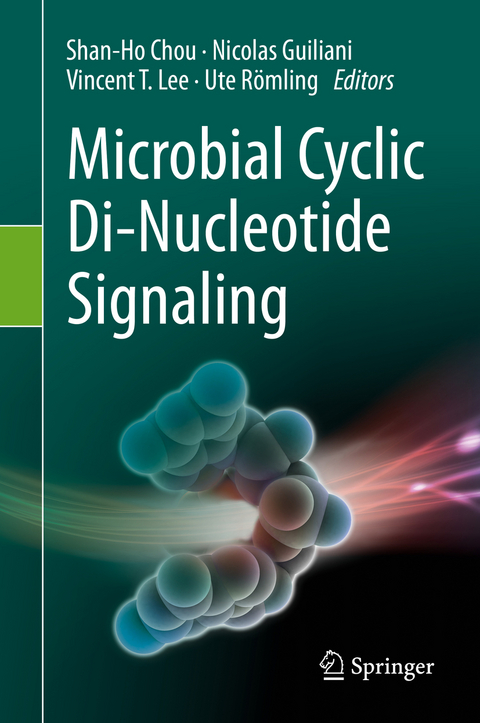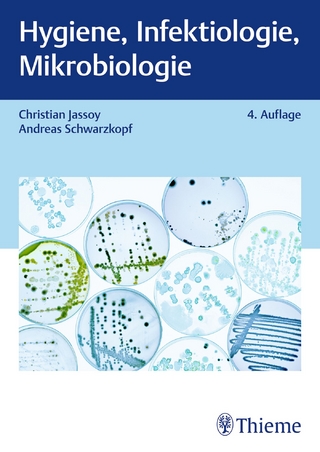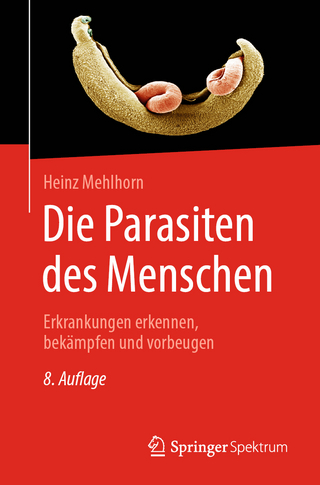
Microbial Cyclic Di-Nucleotide Signaling
Springer International Publishing (Verlag)
978-3-030-33307-2 (ISBN)
This book explores the broad and diverse biological and physiological impacts of established and newly discovered cyclic di-nucleotide second messenger signaling systems, while also providing descriptions of the intriguing biochemical characteristics of multiple turnover enzymes and receptors. The respective chapters discuss the commonalities and diversity of cyclic di-GMP, cyclic di-AMP and recently discovered cyclic GMP-AMP signaling systems in manifold Gram-negative and Gram-positive bacteria. The global human pathogens Mycobacterium tuberculosis, Vibrio cholerae, Salmonella typhimurium, Escherichia coli and Streptococcus pneumoniae, the facultative human pathogen Pseudomonas aeruginosa, global plant pathogens as exemplified by Xanthomonas campestris and Burkholderia spp., and the omnipresent probiotic Lactobacilli, as well as environmentally importantphotoautotrophic cyanobacteria, the multicellular Myxococcus xanthus, and chemolithotrophic Acidithiobacillus are among the representatives of the microbial kingdom that are described.
In turn, the various aspects of bacterial physiology affected by these signaling systems- e.g. biofilm formation and dispersal, the cell cycle, motility, virulence, production of antimicrobials, fundamental metabolism and osmohomeostasis - are discussed in detail in the context of different microorganisms. Dedicated chapters focus on the population diversity of cyclic dinucleotide signaling systems, their tendency to be horizontally transferred, the cyclic di-GMP signaling system in the social amoeba Dictyostelium, honorary cyclic (di)nucleotides, and the development of strategies for interfering with cyclic dinucleotide signaling in order to manipulate microbial behavior.
Taken together, the chapters provide an authoritative source of information fora broad readership: beginners and advanced researchers from various disciplines; individuals seeking a broad overview of cyclic di-nucleotide signaling; and those who want to learn more about specific aspects. Also featuring reviews with a forward-looking perspective, the book offers a valuable source of inspiration for future research directions.
Shan-Ho Chou is currently a chair professor of the Institute of Biochemistry, National Chung Hsing University, Taiwan. He received his bachelor's degree in chemistry from the National Taiwan Normal University, a master's degree in biochemistry from the National Taiwan University, and a Ph.D. in chemistry from the University of Washington in Seattle, WA. He has been interested in studying protein and unusual nucleic acid complex structures and found several stable nucleic acid structures different from the WC base-paired duplex, which were published in several review papers in the Journal of Molecular Biology, Nucleic Acids Research and Trends in Biochemistry. He is now combining X-ray, nuclear magnetic resonance, and cryo-electron microscopy techniques to study the structures and functions of multi-domain proteins complexed with cyclic di-GMP and cyclic di-AMP. Nicolas Giuliani received his PhD from the Université Aix-Marseille, France. He is actually full professor of Microbiology and Biotechnology at the Facultad de Ciencias, Universidad de Chile in Santiago, Chile. His research is focused on the deciphering of molecular events involved in biofilm formation by acidophilic bacteria currently used in biomining processes. Initially focused on the characterization of quorum sensing systems, his research activities are now dealing with cyclic di-nucleotide second messenger signalling and the regulation of exopolysaccharides in Acidithiobacillus species. Nicolas Guiliani was President of the Chilean Society of Microbiology (SOMICH, 2013-2016) and President of the Association of Latinamerican Societies for Microbiology (ALAM, 2016-2018). Vincent Lee is an associate professor of Cell Biology and Molecular Genetics at the University of Maryland at College Park, USA. His long-standing research interests include bacterial pathogenesis, biofilm formation and regulation of microbial physiology by signaling nucleotides. One major focus in his research on signaling nucleotides is the identification of receptors that mediate the down-stream regulation by these signals. Ute Römling is professor of Microbial Physiology at the Karolinska Institutet in Stockholm, Sweden. Her long-standing research interest is the molecular and epidemiological analysis of biofilm formation in microorganisms with a focus on regulation by cyclic di-nucleotide second messenger signaling, implication of extracellular matrix production and biofilm-host interactions. Another major long-standing research interest concerns the survival and persistence mechanisms of a world-wide predominant clone of Pseudomonas aeruginosa found in patients and aquatic habitats. Ute Römling is a member of the European Academy of Microbiology, AcademiaNet and an adjunct faculty member at the University of Karachi, Pakistan.
Part I:Biochemistry/Structural Biology - Enzymes.- Chapter 1: Cyclic Dinucleotide Signaling In Mycobacteria.- Chapter 2: Structure and regulation of EAL domain proteins.- Chapter 3: Insights into the molecular basis of biofilm dispersal from crystal structures of di-domain containing proteins.- Chapter 4: Structure and function of HD-GYP phosphodiesterases.- Chapter 5: A unified catalytic mechanism for c-di-NMP hydrolysis by DHH/DHHA1 phosphodiesterases.- Chapter 6: Enzymatic degradation of linear dinucleotide intermediates of cyclic dinucleotides.- Part II:Biochemistry/Structural Biology - Receptors.- Chapter 7: Detection of cyclic dinucleotide binding proteins.- Chapter 8: Non-canonical c-di-GMP binding modes.- Part III:Biochemistry/Structural Biology - Sensing.- Chapter 9: Sensory domains that control cyclic di-GMP-modulating proteins: a critical frontier in bacterial signal transduction.- Part IV:Cyclic di-AMP biochemistry and physiology.- Chapter 10: Metabolic regulationby cyclic di-AMP signaling.- Chapter 11: Osmoregulation via cyclic-di-AMP signaling.- Part V:Population diversity.- Chapter 12: Measuring individual cell c-di-GMP: Identifying population diversity and c-di-GMP heterogeneity.-Part VI:Cyclic di-GMP and exopolysaccharide regulation.- Chapter 13: Activation of bacterial cellulose biosynthesis by cyclic-di-GMP.- Chapter 14: The Regulation of Alginate Biosynthesis viaC-di-GMPSignaling.- Part VII:Environmental bacteria.- Chapter 15: Cyclic di-GMP Signaling in Bacillus subtilis.- Chapter 16: C-di-GMP signaling systems in the Gram-positive Bacillus cereus group.- Chapter 17: Cyclic-di-AMP in Bacillus subtilisbiofilm formation.-Chapter 18: Regulation by c-di-GMP in Myxococcusxanthus.- Chapter 19: Light-regulated nucleotidesecond messenger signalingin cyanobacteria.- Chapter 20: C-di-GMP-dependent regulation of antibiotic biosynthesis in Lysobacter.- Chapter 21: Cyclic di-GMP signalingin extreme acidophilic bacteria.- Part VIII:Pathogens.- Chapter 22: Signals modulating cyclic di-GMP pathways in Vibrio cholera.- Chapter 23: Cyclic di-GMP regulation of gene expression.- Chapter 24: Cyclic di-GMP signaling in Salmonella enterica serovar Typhimurium.- Chapter 25: Cyclic di-GMP signaling in the phytopathogen Xanthomonas campestris pv. Campestris.- Chapter 26: Cyclic di-AMP in Mycobacterium tuberculosis.- Chapter 27: Cyclic di-AMP signaling in Streptococcus pneumonia.- Part IX:Gram-negative bacteria.- Chapter 28: Regulation of cyclic-di-GMP signaling in Pseudomonas aeruginosa.- Chapter 29: Unconventional Cyclic di-GMPSignalling in Escherichia coli.- Chapter 30: Cyclic di-GMP in Burkholderia spp.- Chapter 31: Cyclic di-GMP and the regulation of biofilm dispersion.- Part X:Cyclic di-GMP signaling in eukaryotes.- Chapter 32: Cyclic-di-GMP activates adenylate cyclase A and protein kinase A to induce stalk formationin Dictyostelium.- Part XI:Interference Strategies.- Chapter 33: Targeting cyclic di-nucleotide signaling with small molecules.- Part XII:Novel cyclic di-nucleotides.- Chapter 34: Cyclic di-GMP signaling gone astray: cGAMP signaling via Hypr GGDEF and HD-GYP enzymes.- Chapter 35: Microbial cyclic GMP-AMP signaling pathways.-Part XIII:Honorary cyclic nucleotides.- Chapter 36: 2',3'-cyclic mononucleotide metabolism and possible roles in bacterial physiology.- Part XIV:Horizontal gene transfer.- Chapter 37: Horizontal transfer of c-di-GMP associated genes. Theoretical underpinnings and future perspectives.-Part XV:Conclusion.- Chapter 38: Conclusion.
| Erscheinungsdatum | 06.03.2020 |
|---|---|
| Zusatzinfo | XVIII, 657 p. 108 illus., 96 illus. in color. |
| Verlagsort | Cham |
| Sprache | englisch |
| Maße | 155 x 235 mm |
| Gewicht | 1172 g |
| Themenwelt | Medizin / Pharmazie ► Medizinische Fachgebiete ► Mikrobiologie / Infektologie / Reisemedizin |
| Naturwissenschaften ► Biologie ► Biochemie | |
| Naturwissenschaften ► Biologie ► Mikrobiologie / Immunologie | |
| Schlagworte | 2'3 cyclic AMP • 2’3 cyclic AMP • Bacterial signaling • biofilm formation • cyclic di-AMP • cyclic di-GMP • cyclic GAMP • Microbiology • Motility • receptors • Second messengers • Virulence |
| ISBN-10 | 3-030-33307-8 / 3030333078 |
| ISBN-13 | 978-3-030-33307-2 / 9783030333072 |
| Zustand | Neuware |
| Informationen gemäß Produktsicherheitsverordnung (GPSR) | |
| Haben Sie eine Frage zum Produkt? |
aus dem Bereich


